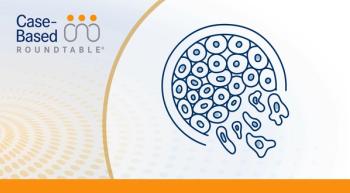
Standard Approach to Treating DLBCL
Nathan H. Fowler, MD:Large cell lymphoma is 1 of the most common types of non-Hodgkin lymphomas. It occurs in over 25,000 newly diagnosed patients each year in the United States. And unfortunately, it’s 1 of those diseases that can become very aggressive. Many times, patients present with symptoms. Sometimes they present with pain, fevers, and chills, along with compromised organ function, depending where the large cell lymphoma is occurring.
When patients are first seen in the clinic with diffuse large B-cell lymphoma, the first thing for the clinician to establish is the type of aggressive lymphoma. There are actually several subtypes of diffuse large B-cell lymphoma, and some of the subtypes can behave a bit more aggressively than others.
When we’re seeing patients for the first time, we often go through several frontline treatment regimens. In the United States, I would say the most common of the frontline regimens we use today is a regimen called R-CHOP [rituximab, cyclophosphamide, doxorubicin hydrochloride, vincristine, prednisone]. This is rituximab with a combination of chemotherapy drugs that is used usually every 3 weeks for a total of 6 cycles.
There are some data with more aggressive or large-cell lymphomas that have some different mutational profiles to use regimens like rituximab plus EPOCH [etoposide, prednisone, vincristine, cyclophosphamide, doxorubicin hydrochloride] chemotherapy. This is a combination chemotherapy in which we dose adjust each regimen based [on] the patient’s blood counts. There were some randomized trials comparing these 2 regimens, and they look fairly similar. But I think in practice, many of us would use CHOP [cyclophosphamide, doxorubicin hydrochloride, vincristine, prednisone]based regimens for the kind of garden variety of large-cell lymphomas. If a patient has a more aggressive phenotype, a more aggressive mutational profile, sometimes we use regimens like dose-adjusted EPOCH [etoposide, prednisone, vincristine, cyclophosphamide, doxorubicin hydrochloride] with rituximab.
When patients relapse after frontline therapy, there are a lot of treatment options. To put it in perspective, with frontline regimens, the cure rateor I should say, kind of the long-term remission rate—is usually somewhere around 50% to as high as 70%, depending on the study you look at. That means that 30% to 50% of patients, at some time, unfortunately will often relapse following frontline therapy. Those relapses usually occur somewhere between 6 months and 2 years. If patients go beyond 2 years, the odds of relapse really drop significantly.
But when patients relapse, the first thing I do, as a clinician, is see what the relapse looks like. If they’ve had several years of remission, it’s very important to rebiopsy the patient and confirm that it still is large-cell lymphoma. Sometimes patients can relapse with a different type of lymphoma or different malignancy. Assuming that we see a patient in the clinic [and] they’ve had a large-cell lymphoma at diagnosis, they receive a combination regimen, and they relapse in fairly short order, and it’s still large-cell lymphoma, then the standard of care in the United Statesif the patient has a good performance status—would be to use a combination approach with a monoclonal antibody, such as rituximab, usually with a different combination from what they had in the frontline. This would include things like ICE [ifosfamide, carboplatin, etoposide] chemotherapy, or some other regimen like DHAP [dexamethasone, high-dose cytarabine, cisplatin], or sometimes gemcitabine and oxaliplatin if patients have a slightly lower performance status.
If patients achieve a remission with 1 of these salvage options, the next step is always to proceed with an autologous stem cell transplant. This is because there have been several studies that have been done in the past that have suggested that patients who achieve a remission with ICE [ifosfamide, carboplatin, etoposide], or DHAP [dexamethasone, high-dose cytarabine, cisplatin], or gemcitabine and oxaliplatin, or 1 of these regimenswho then proceed to a stem cell transplant—can be cured with things like an autologous stem cell transplant. Now, you may have noticed that I mentioned patients who achieve a remission. It’s imperative that patients have some response to the salvage therapy before they go to transplant.
Several trials have suggested that patients who fail to respond to 1 of these salvage regimens who then go on to transplant do not have, unfortunately, good outcomes. So generally, we don’t proceed to stem cell transplant unless the patient has a good response to their salvage regimen. Sometimes we have to actually do a couple of different types of salvage regimens to get patients in that remission to proceed with stem cell transplant.
Transcript edited for clarity.









































